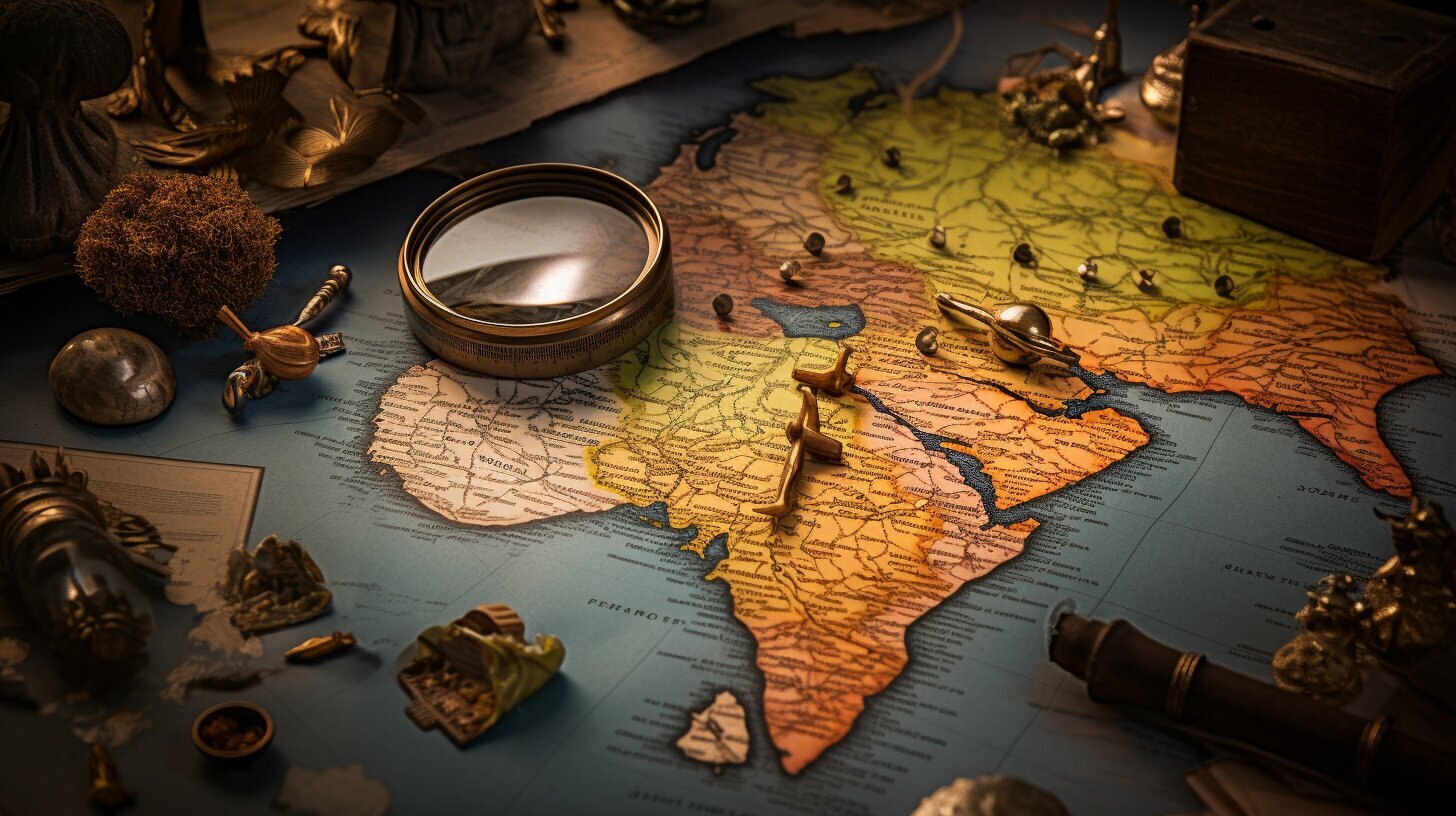Unraveling Why India is Called a Subcontinent: A Deeper Look
India is commonly referred to as a subcontinent, but have you ever wondered why this term is used and what it actually means? In this article, we will delve deeper into the reasons behind India being called a subcontinent and explore its unique definition within the context of the Indian subcontinent.
Key Takeaways:
- India is called a subcontinent because it is politically and geographically separate from the rest of Asia.
- The Indian subcontinent covers 2.4% of the earth’s land area and has natural frontiers like the Himalayas and the Deccan Peninsula.
- The Indian subcontinent includes countries such as India, Pakistan, Nepal, Bhutan, Bangladesh, Sri Lanka, and the Maldives.
- The people of the subcontinent share ethnic, linguistic, cultural, and historical connections.
- India used to be a continent, but due to continental drift, it became a part of Asia.
Geographical Features of the Indian Subcontinent
The Indian subcontinent boasts a diverse range of geographical features that contribute to its distinctiveness and significance. Covering 2.4% of the earth’s land area, this region is politically and geographically separate from the rest of Asia, with natural frontiers such as the majestic Himalayas and the expansive Deccan Peninsula.
The Himalayas, one of the world’s most spectacular mountain ranges, stretches across the northern border of the Indian subcontinent, providing a formidable barrier between the region and the rest of Asia. With breathtaking peaks, including Mount Everest, and an intricate network of rivers, these mountains shape the geography of the subcontinent and influence its climate and biodiversity.
Further south, the Deccan Peninsula stands as a sprawling plateau that encompasses a significant portion of the subcontinent. It is characterized by its rugged terrain and diverse ecosystems, ranging from arid plains to lush forests. The Deccan Plateau is flanked by the Eastern Ghats and the Western Ghats, mountain ranges that contribute to the region’s natural beauty and act as barriers to weather patterns.
| Geographical Features | Description |
|---|---|
| Himalayas | The world’s highest mountain range, acting as a natural border between the subcontinent and Asia. |
| Deccan Peninsula | A vast plateau with diverse terrains, including plains, forests, and mountains. |
| Eastern Ghats | A mountain range running along the eastern coast of the subcontinent, influencing the region’s weather patterns. |
| Western Ghats | A mountain range parallel to the western coast of the subcontinent, known for its rich biodiversity. |
| Rivers | A network of major rivers, such as the Ganges, Indus, Brahmaputra, and Krishna, shaping the landscape and supporting agriculture. |
The Indian subcontinent is also defined by its extensive river systems. The mighty Ganges, Indus, Brahmaputra, and Krishna rivers, among others, flow through its heart, shaping the landscape, and supporting agriculture. These rivers not only provide water for irrigation but also hold immense cultural and spiritual significance for the people of the region.
From the snow-capped peaks of the Himalayas to the sprawling Deccan Peninsula, the Indian subcontinent showcases a remarkable variety of geographical features. These features not only contribute to the region’s ecological diversity but also shape its history, culture, and way of life.
Historical Significance of the Indian Subcontinent
To truly understand why India is deemed a subcontinent, we must delve into its rich historical past and the evolution of the term itself. The Indian subcontinent has a long and complex history, shaped by various historical events and cultural influences. Its significance lies in its distinct geographical and cultural characteristics, as well as its role as a bridge between different civilizations.
The term “subcontinent” was first used by Europeans in the 19th century to describe the vast landmass comprising present-day India, Pakistan, Bangladesh, Nepal, Bhutan, and Sri Lanka. These countries, along with the Maldives, make up the Indian subcontinent today. However, the subcontinent’s history predates the arrival of Europeans.
Before the term “subcontinent” came into use, the region was known by various names in different periods of history. In ancient times, it was referred to as “Bharata” or “Aryavarta” in Sanskrit texts, signifying the land of the Bharat dynasty and the noble Aryan civilization. Over the centuries, the Indian subcontinent saw the rise and fall of numerous dynasties, empires, and kingdoms, each leaving its mark on the region’s cultural and historical landscape.
The Indian subcontinent played a pivotal role in the development of civilization in South Asia and beyond. Its location between the Arabian Sea and the Bay of Bengal facilitated trade and cultural exchanges with other regions, leading to the emergence of complex societies and diverse cultures. The subcontinent was a melting pot of various ethnic groups, languages, religions, and artistic traditions.
Throughout its history, the Indian subcontinent witnessed significant events that shaped its identity. It was the birthplace of major religions like Hinduism, Buddhism, Jainism, and Sikhism. The region also experienced the arrival of Persian, Greek, Turkish, and Mongol invasions, which influenced its cultural and political landscape. The Indian subcontinent was a hub of trade and intellectual exchange, attracting scholars, traders, and travelers from around the world.
The transformation of India from a separate continent to a part of Asia occurred due to the process of continental drift over millions of years. The movement of tectonic plates resulted in the collision of the Indian Plate with the Eurasian Plate, leading to the formation of the Himalayas and the integration of the Indian subcontinent into the Asian landmass. This geological process played a crucial role in shaping the topography and natural frontiers of the region.
| Key Points | Historical Significance of the Indian Subcontinent |
|---|---|
| Definition | The Indian subcontinent comprises India, Pakistan, Bangladesh, Nepal, Bhutan, Sri Lanka, and the Maldives. |
| Distinct Identity | The Indian subcontinent is geographically and culturally distinct, with natural frontiers like the Himalayas and a rich history of civilization. |
| Cultural Exchange | The subcontinent has been a melting pot of diverse ethnic groups, languages, religions, and artistic traditions, contributing to its cultural richness. |
| Historical Events | The Indian subcontinent has witnessed the rise and fall of dynasties, the development of major religions, and the arrival of various invasions, all shaping its historical legacy. |
| Continental Drift | The integration of the Indian subcontinent into Asia occurred due to the movement of tectonic plates and the formation of the Himalayas. |
Cultural Diversity of the Indian Subcontinent
The Indian subcontinent is a vibrant tapestry of cultures, languages, and traditions, with each region contributing to its vibrant mosaic. Spanning across multiple countries, this diverse land is home to a rich heritage that dates back thousands of years. From the ancient civilizations of the Indus Valley to the majestic palaces of Rajasthan, the subcontinent encapsulates a wealth of historical and cultural treasures.
One of the remarkable aspects of the Indian subcontinent is its linguistic diversity. With more than 1,600 languages spoken, it boasts one of the highest language diversities in the world. Hindi, Bengali, Urdu, Tamil, and Telugu are just a few examples of the many languages that thrive within this region, each with its own unique script, literature, and expressions.
The subcontinent also showcases a remarkable mix of religions, including Hinduism, Islam, Buddhism, Sikhism, and Jainism. Ancient temples, grand mosques, and serene monasteries stand as testaments to the spiritual beliefs that have shaped the lives of millions of people. Festivals like Diwali, Eid, Holi, and Durga Puja bring communities together, showcasing the vibrant colors, music, and traditions of the subcontinent.
| Country | Capital | Official Language(s) |
|---|---|---|
| India | New Delhi | Hindi, English |
| Pakistan | Islamabad | Urdu, English |
| Nepal | Kathmandu | Nepali |
| Bhutan | Thimphu | Dzongkha |
| Bangladesh | Dhaka | Bengali |
| Sri Lanka | Colombo | Sinhala, Tamil |
| Maldives | Male | Dhivehi |
The Indian subcontinent is an enchanting land where traditions seamlessly blend with modernity, and ancient philosophies continue to inspire. It is a place where diverse cultures coexist, influencing each other and shaping a unique identity. From the culinary delights of biryani and dosa to the colorful textiles of silk and cotton, every aspect of life in the subcontinent reflects its rich cultural heritage.
Countries of the Indian Subcontinent
The Indian subcontinent is home to several countries, each with its own unique identity and contribution to the region’s rich heritage. Let’s explore the countries that make up this diverse and geographically distinct subcontinent.
India
As the largest country in the Indian subcontinent, India is known for its vibrant culture, ancient history, and diverse landscapes. From the iconic Taj Mahal to bustling cities like Mumbai and Delhi, India offers a tapestry of experiences for travelers. With a population of over 1.3 billion, India is a melting pot of languages, religions, and traditions.
Pakistan
Situated in the western part of the Indian subcontinent, Pakistan shares its borders with India, Afghanistan, Iran, and China. Known for its rich history, vibrant festivals, and stunning landscapes, Pakistan offers a unique blend of Islamic heritage and natural beauty. The country is home to famous landmarks like the ancient city of Mohenjo-daro and the stunning Karakoram mountain range.
Nepal
Nepal, nestled in the Himalayas, is renowned for its breathtaking mountain peaks, including Mount Everest, the highest peak in the world. The country’s rich cultural heritage is reflected in its many temples, monasteries, and historic sites. Nepal is a popular destination for trekking enthusiasts and spiritual seekers, offering an unforgettable experience amidst its awe-inspiring natural beauty.
Bhutan
Known as the “Land of the Thunder Dragon,” Bhutan is a country of stunning landscapes and unique traditions. With its emphasis on Gross National Happiness and preservation of traditional Bhutanese culture, the country offers a truly immersive experience. From the iconic Tiger’s Nest Monastery to its vibrant festivals, Bhutan is a hidden gem in the Indian subcontinent.
Bangladesh
Situated on the Bay of Bengal, Bangladesh is known for its lush delta landscapes and vibrant cultural heritage. The country is home to the Sundarbans, the largest mangrove forest in the world and a UNESCO World Heritage site. Bangladesh offers a blend of bustling cities, historical sites, and a warm hospitality that enchants visitors.
Sri Lanka
Sri Lanka, an island nation located off the southeastern coast of India, is renowned for its stunning beaches, ancient ruins, and vibrant wildlife. From the UNESCO World Heritage site of Sigiriya to the tranquil tea plantations of Nuwara Eliya, Sri Lanka captivates with its natural beauty and rich history. The country is also famed for its warm hospitality and flavorful cuisine.
The Maldives
Comprised of 26 coral atolls, the Maldives is a tropical paradise famous for its pristine beaches, crystal-clear waters, and luxury resorts. This archipelago offers a haven for relaxation, underwater exploration, and water sports. With its picture-perfect scenery and serene atmosphere, the Maldives is a destination that promises an idyllic escape.
Summary
In summary, the Indian subcontinent is home to a diverse array of countries, each with its own unique identity and contributions to the region’s rich heritage. From the bustling cities of India and Pakistan to the awe-inspiring landscapes of Nepal and Bhutan, and the tropical beauty of Bangladesh, Sri Lanka, and the Maldives, the subcontinent offers a wealth of experiences for travelers. These countries showcase the cultural, historical, and natural treasures that make the Indian subcontinent a fascinating and enchanting destination.
Population Dynamics of the Indian Subcontinent
With a vast population and diverse ethnicities, the Indian subcontinent holds a unique position in terms of its population dynamics. Spanning across countries like India, Pakistan, Nepal, Bhutan, Bangladesh, Sri Lanka, and the Maldives, this region is home to approximately 1.7 billion people, making it one of the most densely populated areas in the world.
The population of the Indian subcontinent is characterized by its rich diversity, with numerous ethnic groups coexisting and contributing to the cultural tapestry. The major ethnicities include Indo-Aryans, Dravidians, Tibeto-Burmans, and Mongoloids, among others. Each group brings its distinct traditions, languages, and customs, leading to a vibrant and pluralistic society.
Moreover, the Indian subcontinent experiences significant variations in population distribution. While regions like northern India and Pakistan have higher population densities, areas like the Himalayas and northern parts of Nepal have lower population concentrations due to their challenging terrain. This diversity in population distribution contributes to the unique socioeconomic and demographic characteristics observed in different parts of the subcontinent.
| Country | Population | Area (sq km) |
|---|---|---|
| India | 1,366,417,754 | 3,287,263 |
| Pakistan | 216,565,318 | 881,913 |
| Nepal | 30,323,766 | 147,516 |
| Bhutan | 754,394 | 38,394 |
| Bangladesh | 166,303,498 | 147,570 |
| Sri Lanka | 22,576,592 | 65,610 |
| Maldives | 515,696 | 298 |
In conclusion, the population dynamics of the Indian subcontinent are shaped by its vast population, ethnic diversity, and variations in population distribution across the region. Understanding these dynamics is essential for comprehending the social, cultural, and economic fabric of this diverse subcontinent.
India’s Continental Transformation
The transformation of India from a continent to a subcontinent is a fascinating journey shaped by geological forces and historical developments. India, along with its neighboring countries, is considered a subcontinent because it is distinct from the rest of Asia in terms of its political and geographical characteristics. Spanning approximately 2.4% of the Earth’s land area, the Indian subcontinent is demarcated by natural frontiers such as the majestic Himalayas in the north and the vast Deccan Peninsula in the south.
One of the prime factors that led to India’s continental transformation was continental drift. Over millions of years, tectonic forces caused the Indian landmass to break away from the ancient supercontinent, Gondwana, and gradually move northward. This movement gave rise to the formation of the Indian subcontinent as we know it today. As India drifted north, it collided and fused with the Eurasian Plate, resulting in the emergence of the Himalayan mountain range, one of the most stunning geological features on Earth.
However, the continental transformation of India is not solely the result of geological processes. Historically, India has witnessed numerous invasions, migrations, and interactions with neighboring regions, which have played a significant role in shaping its identity as a subcontinent. The diverse cultures, languages, and traditions of the people living in India and its neighboring countries are testament to the rich historical connections that bind the subcontinent together.
In conclusion, India’s journey from being a separate continent to becoming a subcontinent within Asia is a captivating tale of both geological forces and historical events. The unique geographical features, shared ethnic and cultural ties, and historical significance of the Indian subcontinent contribute to its distinction and why it is called a subcontinent. By understanding India’s continental transformation, we gain a deeper appreciation for the remarkable diversity and resilience that characterizes this vibrant part of the world.
| Key Points | Summary |
|---|---|
| Geological Forces | Continental drift and collision with the Eurasian Plate shaped India’s transformation. |
| Historical Significance | The subcontinent’s diverse cultures and historical connections contribute to its identity. |
| Geographical Features | Natural frontiers like the Himalayas and Deccan Peninsula set the subcontinent apart. |
| Cultural Diversity | Shared ethnicities, languages, and traditions thrive within the Indian subcontinent. |
Conclusion
Through this exploration, we have unraveled the reasons why India is known as a subcontinent, delving into its geography, history, culture, and population dynamics. India is called a subcontinent because it is a part of Asia that is politically and geographically separate from the rest of the continent. Covering 2.4% of the earth’s land area, the Indian subcontinent is defined by natural frontiers such as the towering Himalayas and the expansive Deccan Peninsula, which give it a unique identity.
The Indian subcontinent comprises diverse and vibrant countries, including India, Pakistan, Nepal, Bhutan, Bangladesh, Sri Lanka, and the Maldives. The people of these nations share deep ethnic, linguistic, cultural, and historical connections, fostering a rich tapestry of traditions and customs that make the subcontinent a truly fascinating place.
Historically, India was once a separate continent, but over time, it became a part of Asia due to the phenomenon of continental drift. This transformative process resulted in the integration of India into the larger Asian landmass, shaping its current geographical and cultural landscape.
So, when we refer to India as a subcontinent, we acknowledge its distinctiveness and significance as a separate entity within the vast continent of Asia. The term “subcontinent” captures not only India’s geographical attributes but also its diverse history, cultures, and population dynamics that collectively contribute to its unique identity.
FAQ
Why is India called a subcontinent?
India is called a subcontinent because it is a part of Asia that is politically and geographically separate from the rest of the continent.
What is the definition of the Indian subcontinent?
The Indian subcontinent encompasses countries like India, Pakistan, Nepal, Bhutan, Bangladesh, Sri Lanka, and the Maldives. It is characterized by its unique ethnic, linguistic, cultural, and historical connections.
What are the geographical features of the Indian subcontinent?
The Indian subcontinent covers 2.4% of the Earth’s land area and has natural frontiers such as the Himalayas and the Deccan Peninsula. These features contribute to its distinct identity.
Why is the Indian subcontinent historically significant?
The Indian subcontinent has a rich historical background and was once a separate continent. Over time, it became integrated into Asia due to continental drift, making it historically significant.
What is the cultural diversity of the Indian subcontinent?
The Indian subcontinent is known for its cultural diversity, with a wide range of ethnicities, languages, traditions, and historical connections existing within its borders.
Which countries are part of the Indian subcontinent?
The Indian subcontinent includes countries such as India, Pakistan, Nepal, Bhutan, Bangladesh, Sri Lanka, and the Maldives.
What are the population dynamics of the Indian subcontinent?
The population dynamics within the Indian subcontinent are characterized by a significant population size, growth, distribution, and diversity.
Why did India transition from a continent to part of Asia?
India transitioned from being considered a separate continent to becoming part of Asia due to the impacts of continental drift and geological changes over time.






